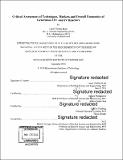Critical assessment of techniques, markets and overall economics of Generation III+ and IV reactors
Author(s)
Rush, Lucas Thorley.
Download1103918600-MIT.pdf (23.95Mb)
Other Contributors
Massachusetts Institute of Technology. Department of Nuclear Science and Engineering.
Advisor
Jacopo Buongiorno.
Terms of use
Metadata
Show full item recordAbstract
This thesis performs a high-level assessment of the economic potential of Generation III+ and IV reactors. It examines both a market and product-based approach for the cost of new nuclear installations. It is the contention of this author that the support of the economic benefits for Generation IV reactors is unwarranted. Based on the uncertainties and lack of detailed design engineering completed, there is not sufficient evidence to suggest that Generation IV reactors, solely by virtue of their different design, will have higher economic potential than current LWRs. A market-based approach was initially taken to determine the upper bound for the cost of nuclear power. In every case, except when the Generation IV reactors had a low operating cost, their capital cost had to be lower than that of a LWR, due to their higher enrichment requirements. It was found that a change of ~0.1 c/kWh in the operation cost corresponded to a cost differential of ~200 $/kW in the capital cost. Due to the high capital costs and relatively low revenue streams of new nuclear plants it was found that their commercial success was highly sensitive to the capital cost with even mild increases in cost having a significant effect over the entire project. This lead to the conclusion that the ability to guarantee returns on an investment potentially limits nuclear projects to regulated markets. A product-based approach was then used to assess the real and estimated costs of Generation III+ and IV reactors. It was found that the cost breakdown of each Generation III+ reactor was similar, however, the overall cost varied significantly by region. The installation costs where the most significant portion of the costs, ranging from 40-50%, with the nuclear and turbine island equipment costs only represented between 17-25% of the total overnight cost. The estimated costs for the different Generation IV designs from modern estimates were all localized around 4,750 $/kW, while earlier estimates place the cost much lower, around 1,750 $/kW. The uncertainty in cost estimation, both its effects and its sources, was examined. It was found that when cost information over five years old was used, then the uncertainty in cost escalation was significant. A major factor that was found to have an effect on the reliability of cost estimates was also the design maturity. Novel projects with lower design maturity projects systematically under-predict the final cost resulting in cost escalation with time. A common proposition for Generation IV reactors is that they are used for process heat applications. A study of all industrial sites in the United States, and extended to the world, found that the number of potential sites are lower than expected due to two major reasons. Firstly, the consumption of by-product streams for heat generation in major energy users, i.e. refineries, form a major component of their heat supply. Secondly, the commercial development of technologies that can actually utilize the process heat for high temperature products, such as hydrogen, have not been completed. A major potential strength would be the requirement of CO₂ free heat for the transportation sector. This would also require the development of other significant technologies, such as biofuels, to be feasible. Should a transition to hydrogen and/or synthetic fuels occur in the transportation sector, the economic opportunity to use nuclear reactors to generate those fuels would be substantial.
Description
Thesis: S.M., Massachusetts Institute of Technology, Department of Nuclear Science and Engineering, 2018 Cataloged from PDF version of thesis. Includes bibliographical references (pages 127-132).
Date issued
2018Department
Massachusetts Institute of Technology. Department of Nuclear Science and EngineeringPublisher
Massachusetts Institute of Technology
Keywords
Nuclear Science and Engineering.